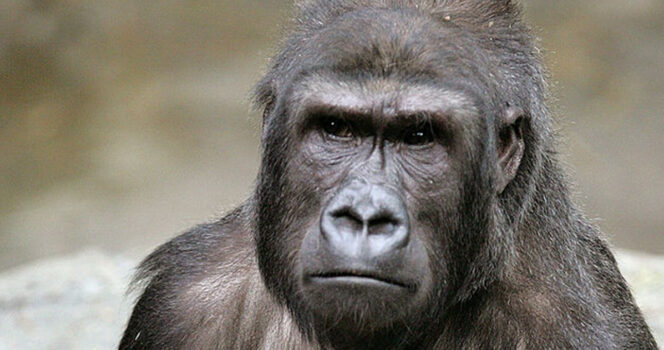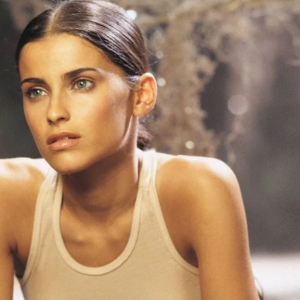Every once in a while, a moment comes along that forces us to rethink everything we believe about animals, empathy, and the invisible threads that tie us all together. That moment happened on a sunny August afternoon in 1996 at Brookfield Zoo in Illinois, and it centered around a western lowland gorilla named Binti Jua.
She wasn’t a superhero in a cape. She didn’t have words to explain her actions. But what she did that day stunned the world—and reminded us that compassion isn’t just a human trait.

A Terrifying Fall in the Gorilla Enclosure
It started like any other zoo visit. Families walked past exhibits, kids pointed in excitement, and the air buzzed with summertime energy. But then, tragedy struck. A 3-year-old boy climbed over a barrier and accidentally plunged 25 feet into the gorilla habitat. The fall knocked him unconscious.
Panic erupted. Onlookers screamed, fearing the worst. Inside the enclosure were seven massive gorillas—strong, powerful creatures that could easily harm a child without even meaning to. What happened next, however, turned horror into awe.
Video: Gorilla Carries 3-Year-Old Boy to Safety in 1996 Incident
Meet the Unlikely Hero: Binti Jua
Binti Jua, a 160-pound female gorilla, was among the group. She was no stranger to the public—born at the zoo in 1988, hand-raised by humans, and trained to care for baby gorillas. But no one could have predicted what she’d do that day.
As the child lay motionless, Binti approached him. With her own baby, Koola, clinging to her back, she gently cradled the boy in her arms. Not aggressively. Not fearfully. Gently—like a mother holding a newborn.
Instincts That Defied Expectations
It was clear she knew the boy needed help. She looked around cautiously, scanning for signs of danger or instruction. Her behavior wasn’t frantic or confused—it was purposeful. And when zookeepers used a hose to push the other gorillas away from the scene, Binti walked over to the exhibit entrance and laid the boy down carefully, then backed away.
Thanks to her actions, paramedics were able to safely enter and retrieve the child. He survived the fall with a broken hand and minor head injuries. It could have been so much worse.
Captured on Camera—A Story the World Had to See
Jeff Bruno, a local fire captain, witnessed the whole thing. His brother-in-law filmed it. That footage quickly made its way into homes across America—and the world. If it hadn’t been caught on camera, some might have doubted the incredible story. But the evidence was undeniable. A gorilla, often portrayed in media as fearsome, had saved a human child.
Why Binti Jua’s Story Went Viral
What made this story so compelling wasn’t just the heroism. It was the unexpected source. For generations, gorillas had been misunderstood—feared because of their size, typecast in films like King Kong as brutes.
But Binti Jua shattered that image with one act of selflessness.
Binti Became a Global Symbol of Empathy
Video: A Conversation With Koko
News outlets couldn’t get enough of her. Newsweek named her “Hero of the Year”. People Magazine listed her among the “Most Intriguing People.” And thousands flocked to Brookfield Zoo to catch a glimpse of the gentle giant whose heart was just as big as her frame.
She was given special treats, praised by zookeepers, and became a face of change—not just for gorillas, but for the way we view all animals.
Training or True Altruism? Experts Weigh In
Some skeptics wondered whether Binti’s actions were just the result of zoo training. After all, she had been taught how to carry baby gorillas and bring them to zookeepers for health checks. But many animal behaviorists believe her behavior went far beyond learned routine.
Frans de Waal, a renowned primatologist, argued that Binti Jua demonstrated a deep, instinctual form of animal altruism—an emotional response to another creature in distress. And honestly, when you watch the footage, it’s hard to disagree.
What Happened to the Boy She Saved?
The identity of the boy was never publicly released. His parents asked for privacy, and the zoo honored that request. What we do know is that he made a full recovery, despite suffering from a head injury and a broken hand.
Doctors later said he had no memory of the incident—a small mercy, perhaps. He was acting normally within days, unaware that he had become part of a story that would live on for decades.
Legacy Beyond One Moment
Binti Jua’s story is more than just a feel-good viral video. It’s a powerful reminder that compassion knows no boundaries—not species, not language, not even biology. It reminds us that just because an animal can’t speak our language doesn’t mean it can’t understand what we’re feeling.
Her legacy is still felt today. She inspired not just zookeepers and researchers but also ordinary people to think differently about the intelligence and emotional lives of animals.
Other Gorillas Who Stepped Up
Binti’s story wasn’t the only one of its kind. In 1986, a gorilla named Jambo at Jersey Zoo protected a boy who fell into his enclosure, too. These moments continue to raise a question scientists are still wrestling with: Are animals capable of empathy, just like us?
The answer may lie in moments like this. Not in a lab. Not in a textbook. But in the quiet, intentional kindness of a gorilla cradling a child.
Final Thoughts: Why Binti Jua Matters Now More Than Ever
In a world that often feels divided, the story of Binti Jua offers something rare: hope. Hope that empathy exists across species. Hope that instinct can be kind, not cruel. Hope that heroes come in all forms—even with fur and giant hands.
Her moment of grace on that summer day in 1996 continues to resonate not just because it was rare, but because it was real. And that kind of story? We never forget.


